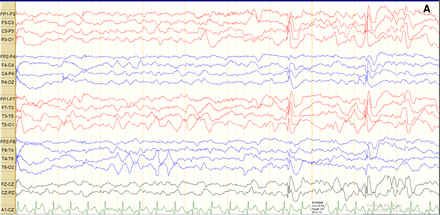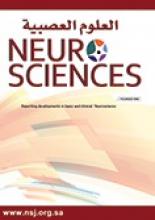A 2-year-old boy with Klippel-Trénaunay syndrome, characterized by extensive port-wine staining and left lower limb hemihypertrophy, and developmental delay, with impairments in cognition, presented with a history of seizures since the age of 18 months. The seizures were of multiple types, including focal seizure with eye deviation to the right side, tonic drop attacks with eye deviation to the right side, and focal-onset myoclonic seizures. Epilepsy was refractory to 2 antiseizure medications. The interictal EEG showed features described in figures 1A and 1B, together with left paroxysmal fast activity during slow sleep in the left hemisphere (not shown) are characteristic features of asymmetric Lennox–Gastaut syndrome.
- The interictal EEG a) reveals an abnormal asymmetric slow spike-wave activity of 1.5 to 2 Hz and wave discharges associated with electrodecrement in the left hemisphere, consistent with findings of asymmetric Lennox–Gastaut syndrome. Settings: sensitivity, 7 μV/mm; high-frequency filter, 70 Hz. b) shows many spikes in multiple left-brain areas (T3, F7, T5, C3, and P3). Settings: sensitivity, 7 μV/mm; high-frequency filter, 70 Hz.
Magnetic resonance imaging (MRI) of the brain revealed left perisylvian cortical malformation and abnormal white matter (Figure 2).
- MRI of the brain. Axial a) and coronal b) T2-weighted images show polymicrogyria with thickened disorganized cortex, mainly perisylvian (arrowheads), associated with mild enlargements of the left hemisphere, and lateral ventricle with an abnormal high signal of the periventricular and deep white matter (arrow), likely representing dysmyelination.
Klippel-Trénaunay syndrome is a rare genetic disorder characterized by complex vascular abnormalities (venous and lymphatic) and overgrowth of tissues and bones. It is PIK3CA-related growth spectrum disorder and involves a somatic gain-of-function mutation in the PIK3CA gene, resulting in dysregulated cell proliferation and angiogenesis.1 Central nervous system abnormalities in Klippel-Trénaunay syndrome include venous malformation, arteriovenous malformations, cavernoma, and aneurysm; hemimegalencephaly, cortical dysplasia, and polymicrogyria are rarely reported.2,3 Seizures is a rare manifestation of Klippel-Trénaunay syndrome; described seizures are mainly focal and associated with cerebral dysgenesis. The epilepsy and EEG abnormalities described here are explained by the hemispheric developmental lesions. EEG in Lennox-Gastaut syndrome classically shows characteristic generalized epileptic activity that is similar in those with lesional, genetic, or unknown causes. Unilateral Lennox-Gastaut syndrome is rarely reported.4
This patient with Klippel–Trénaunay syndrome showed the unique unilateral EEG features of Lennox–Gastaut syndrome and cortical malformation.
- Received December 13, 2020.
- Accepted January 18, 2021.
- Copyright: © Neurosciences
Neurosciences is an Open Access journal and articles published are distributed under the terms of the Creative Commons Attribution-NonCommercial License (CC BY-NC). Readers may copy, distribute, and display the work for non-commercial purposes with the proper citation of the original work.









